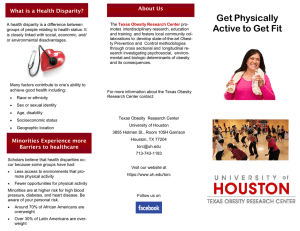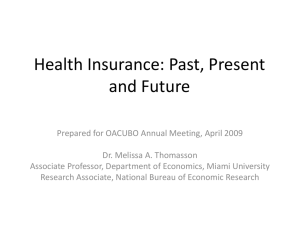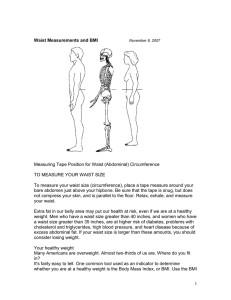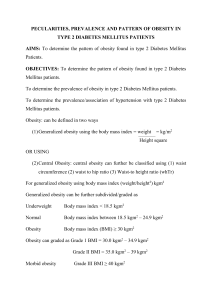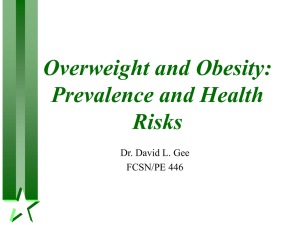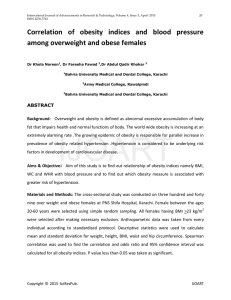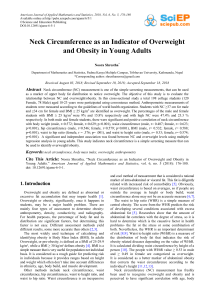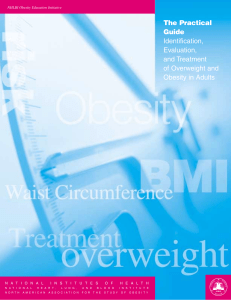Risk Factors & Prevention for What Is a Health Disparity?
advertisement
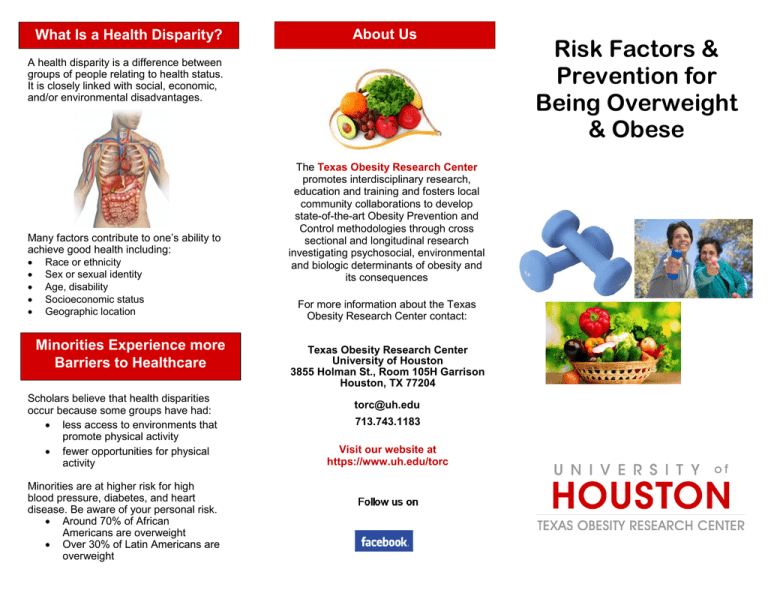
What Is a Health Disparity? About Us A health disparity is a difference between groups of people relating to health status. It is closely linked with social, economic, and/or environmental disadvantages. Many factors contribute to one’s ability to achieve good health including: • Race or ethnicity • Sex or sexual identity • Age, disability • Socioeconomic status • Geographic location Minorities Experience more Barriers to Healthcare Scholars believe that health disparities occur because some groups have had: • less access to environments that promote physical activity • fewer opportunities for physical activity Minorities are at higher risk for high blood pressure, diabetes, and heart disease. Be aware of your personal risk. • Around 70% of African Americans are overweight • Over 30% of Latin Americans are overweight The Texas Obesity Research Center promotes interdisciplinary research, education and training and fosters local community collaborations to develop state-of-the-art Obesity Prevention and Control methodologies through cross sectional and longitudinal research investigating psychosocial, environmental and biologic determinants of obesity and its consequences For more information about the Texas Obesity Research Center contact: Texas Obesity Research Center University of Houston 3855 Holman St., Room 105H Garrison Houston, TX 77204 torc@uh.edu 713.743.1183 Visit our website at https://www.uh.edu/torc Risk Factors Risk Factors & Prevention for Being Overweight & Obese Ten simple strategies that anyone can do to avoid weight gain: Small Steps to Reduce your risk: Increase your physical activity o Park farther away and walk o Take the stairs instead of the elevator or escalator o Take a short walk during your lunch break at work Avoid alcohol, caffeine, and sleeping pills Body Mass Index (BMI) is a general measure of weight for height (kg/m2) to measure disease risk in adults. Underweight Healthy Weight Overweight Obese BMI Below 18.5 18.5-24.9 25.0-29.9 Greater than 30 Drink lots of water every day Avoid yo-yo dieting, or any extreme low-calorie diets Skip the whipped cream or syrup in your morning frappucino Serve meals on smaller plates Turn off the TV and other distractions during meals Stock your fridge and pantry with fresh fruits and vegetables (in readyto-eat portions Risk for Chronic Disease 1. Document the evidence. Write down what and how much you eat of everything to help you to stay in control. 2. Keep on moving. Daily physical activity significantly improves your body functioning. 3. Preempt the tempt. Avoid situations where you are going to be hungry and at risk for making high calorie choices. 4. Plan ahead. Anticipate and make a plan for what you will do in high risk situations. Being overweight, obese or having an undesirable waist circumference can put you at a higher risk for: • Type 2 Diabetes • Heart Disease • High Blood Pressure • Sleep Apnea • Osteoarthritis • Gallbladder Disease You can calculate your BMI online at: http://www.nhlbisupport.com/bmi Waist circumference is used to screen for health risks. To measure waist circumference, place measuring tape at the level of the belly button. Healthy Waist Circumference Women Less than 35 inches Men Less than 40 inches Instructions to measure waist circumference can be found at: http://www.nhlbi.nih.gov/health/ public/heart/obesity/lose_wt/risk.htm 5. Tell a friend. Enlist the help and support of your friends and family. 6. Busy hands. The key is to keep busy and not spend too much time thinking about eating. 7. Talk yourself into it. Tell yourself you can do it 8. Don’t despair. If you fall off the wagon, forgive yourself. And get back on again! 9. Practice relaxing. Stress is a prime cause of overeating. Prioritize time to reflect and relax every day 10. Keep it real. Be realistic with yourself. Don’t expect dramatic weight loss immediately--not a realistic goal.
